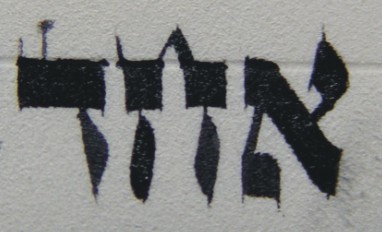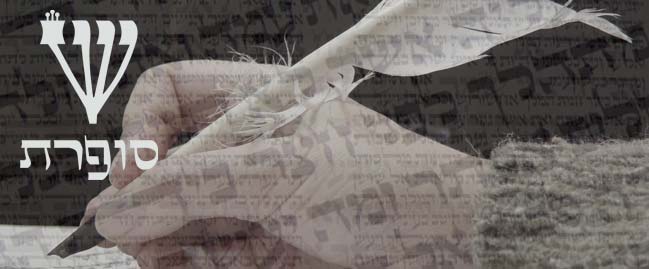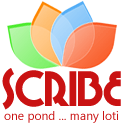ECHAD
BS"D
January 2005: I write the word meaning "one" in Hebrew. The number of G@d. One, United, Singular, Unique, Joint existence & reality for all. There is no other but G@d & there is no-thing else but G@d.
Alef
Value: 1
Alef is the first letter. It has no sound of its own. Only the sound made when you begin to make every sound. Open your mouth and begin to make a sound. STOP! That is Alef. (courtesy R' Lawrence Kushner from his "Book of Letters")
Drash:The mystery of G@D's unified multiplicity is alluded to in the word "alef" ("one"), which spelled backwards is "pele" ("mystery" or "wonder").
There is a tiny Alef written at the end of the first word in Leviticus. "Vayiqra El Moshe..." - "He (G@D) called to Moshe..." Why? The Midrash tells us that when G@D was dictating the Torah to Moshe on Mount Sinai, He chose the word "vayiqra" to show what an intimate relationship they possessed. Moshe, being so modest, was reluctant, wishing to write instead "vayiqar" - "He happened by" - to indicate coincidence in his relationship to G@D rather than chosen-ness. They came to a compromise, thus the small Alef.
Each Holy Letter of the Alef-Bet serves as a channel, connecting heaven and earth. Alef is a ladder. The upper Yud denotes the celestial while the lower Yud represents the mundane. Linking the two Yuds is a Vav, who connects our physical and spiritual inclinations. Alef teaches us that by infusing our everyday lives with holiness, we may ascend to the Divine.
Kavanah: Alef is most easily recognizable by its diagonal stroke. The spot where the left leg meets this diagonal must be above where the right arm intersects it.
The next letter - Chet:
Value: 8
The number eight has great significance in Judaism: boys are circumcised on their eighth day of life; Shemini Atzeret, the Eighth Day of Assembly, ends the holiday of Sukot; there are eight days of Chanukah; tzitzits are made up of eight threads...
Drash:
Going beyond seven, the number eight represents our ability to transcend our physical limitations. Eight symbolizes the metaphysical, the Divine.
When Chet is written in an Ashkenazi (European) Sefer Torah, it consists of two Zayins joined by a peaked roof. This is where Chet gets its name, from "chat" - "distorted". Our Sages draw a lesson from this construction; when one observes two people fighting, whether using verbal or actual weapons (zayins) against each other, spare no effort to built a bridge and bring them together so they may join once again in friendship (Krias HaTorah).
Kavanah:
Make sure the left leg of your Chet stretches from the baseline all the way to the roof, otherwise he could resemble a Hey. Also be careful to not make that leg too long so he isn’t mistaken for a Tav.
Final letter - Dalet:
Value: 4
Drash: Dalet is a door (delet). An open door. A door through which we can experience G@D. Why? Because The Holy One took the Four-Letter-Name, Y-H-V-H, and added a metaphysical open delet to give us a name: Yehudah. Jew.
Dalet is used as an abbreviation of Y-H-V-H, indicating the Four-Letter-Name. The same way Alef stands for Eloqim and Hey for HaShem.
Dalet also represents the poor among us, the dal. The dal is anyone in a state of lack, deprived not necessarily of money, but perhaps of health, strength or knowledge. When any of us are in need, we are the dal.
The top right hand corner of Dalet has a backwards-pointing protuberance like an ear, showing us that the dal pays close attention to the one following him, secretly hoping that help will be offered. Sometimes we are ashamed to ask for help, but would willingly accept it if it were given (Osios R' Akiva). In Torah script, Dalet's leg slants backwards toward Gimel's foot in the Alefbet, as though to teach us that the poor (dal) must make themselves available to the rich (gamol), as they can help each other (Shabbos 104a).
Kavanah: The Dalet has a long roof and a short foot, so it won't be confused with the Khaf Sofit (Final Khaf), whose foot drops below the line. It is also important that the back of the Dalet's head - the upper right hand corner - be clearly squared off so it doesn't resemble a Reysh.
"Echad" has the numerical value of 13, which is also the number of "ahavah", love. Thus we are shown that G@d's love is assured through the universal unity with which Creation was birthed. If we add "echad" to "ahavah", we get the number 26, which is the number of G@d's supreme, 4-letter name, Y-H-V-H.
Shabbat Shalom.














2 Comments:
Welcome to Flickr. com, Aviel!
BS"D
Thanks, Peter!
:D
Post a Comment
<< Home